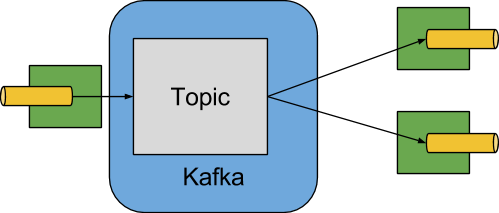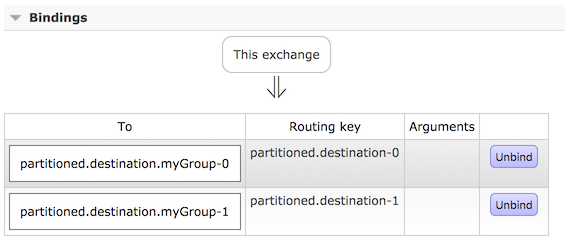Spring Cloud Stream 提供了 Rabbit 和 Kafka 的绑定器实现,但 Rabbit 与 Kafka 的实现结构并不完全相同,这两者与 Spring Cloud Stream 提供的绑定器实现的关联概念需要了解清楚。
Spring Cloud Stream Kafka Binder 参考指南,Spring Cloud Stream RabbitMQ Binder 参考指南,Github > spring-cloud-stream-binder-rabbit,Github > spring-cloud-stream-binder-kafka。
- RabbitMQ 绑定器:在 RabbitMQ 中,通过 Exchange 交换器实现 Spring Cloud Stream 共享主题概念,所以消息通道的输入输出目标映射为了一个具体的 Exchange 交换器。而对于每个消费组,则会对应 Exchange 交换器绑定的 Queue(队列)。
- Kafka 绑定器:Kafka 自身就有了 Topic 概念,所以 Spring Cloud Stream 直接引入了 Kafka 的 Topic 主题概念,每个消费组的通道目标都会直接连接 Kafka 的主题进行消息收发。
绑定器实现依赖已经包含了 spring-cloud-stream ,所以添加该依赖步骤可省略。
Kafka 绑定器
Kafka 绑定器依赖
使用 Apache Kafka 绑定器,需要添加 spring-cloud-stream-binder-kafka 依赖:
<dependency>
<groupId>org.springframework.cloud</groupId>
<artifactId>spring-cloud-stream-binder-kafka</artifactId>
</dependency>
或者使用 Spring Cloud Stream Kafka Starter,starter 包已经包含了 binder 包
<dependency>
<groupId>org.springframework.cloud</groupId>
<artifactId>spring-cloud-starter-stream-kafka</artifactId>
</dependency>
Kafka 绑定器概念
下图显示了 Apache Kafka 绑定器如何运行的简化图:

Apache Kafka Binder 实现将每个目标映射到 Apache Kafka 主题。 消费者组直接映射到相同的Apache Kafka 组。 分区也直接映射到 Apache Kafka 分区。
Kafka 绑定器属性
Kafka 绑定器属性:
属性类:org.springframework.cloud.stream.binder.kafka.properties.KafkaBinderConfigurationProperties
属性前缀:
spring.cloud.stream.kafka.binder.*Kafka 绑定通道属性:
属性类:org.springframework.cloud.stream.binder.kafka.properties.KafkaBindingProperties
Kafka 绑定通道属性类里只有消费者属性类 KafkaProducerProperties 和 生产者属性类 KafkaConsumerProperties 两个。
Kafka 生产者属性:
属性类:org.springframework.cloud.stream.binder.kafka.properties.KafkaProducerProperties
属性前缀:
spring.cloud.stream.kafka.bindings.<channelName>.consumer.*为了避免重复,Spring Cloud Stream 支持以
spring.cloud.stream.default.<property>=<value>格式设置所有通道的值。Kafka 消费者属性:
属性类:org.springframework.cloud.stream.binder.kafka.properties.KafkaConsumerProperties
属性前缀:
spring.cloud.stream.kafka.bindings.<channelName>.producer.*为了避免重复,Spring Cloud Stream 支持以
spring.cloud.stream.default.<property>=<value>格式设置所有通道的值。
Kafka 死信主题
框架无法预测用户将如何处理死信消息,所以不提供任何标准机制来处理它们。如果死信的原因是暂时的,可能希望将消息路由回原始主题;如果问题是一个永久性问题,就可能会导致无限循环。
以下示例 Spring Boot 应用程序是如何将死信消息路由回原始主题的,并且在三次尝试之后它将它们移动到 parking lot 主题。该应用也是一个 spring-cloud-stream 应用程序,它从死信主题中读取,如果 5 秒内没有收到任何消息时终止。
这些示例假设原始目标是 so8400out ,消费者组是 so8400。有几种策略需要考虑:
- 考虑仅在主应用程序未运行时运行重新路由。否则,瞬态错误的重试会很快耗尽。
- 或者,使用两阶段方法:使用此应用程序路由到第三方主题,使用另一个路由从第三方主题返回到主主题。
以下代码示例代码:
application.properties
spring.cloud.stream.bindings.input.group=so8400replay
spring.cloud.stream.bindings.input.destination=error.so8400out.so8400
# 输出目标
spring.cloud.stream.bindings.output.destination=so8400out
spring.cloud.stream.bindings.parkingLot.destination=so8400in.parkingLot
spring.cloud.stream.kafka.binder.configuration.auto.offset.reset=earliest
spring.cloud.stream.kafka.binder.headers=x-retries
Application
@SpringBootApplication
@EnableBinding(TwoOutputProcessor.class)
public class ReRouteDlqKApplication implements CommandLineRunner {
private static final String X_RETRIES_HEADER = "x-retries";
public static void main(String[] args) {
SpringApplication.run(ReRouteDlqKApplication.class, args).close();
}
private final AtomicInteger processed = new AtomicInteger();
@Autowired
private MessageChannel parkingLot;
@StreamListener(Processor.INPUT)
@SendTo(Processor.OUTPUT)
public Message<?> reRoute(Message<?> failed) {
//原子自增
processed.incrementAndGet();
//重试次数
Integer retries = failed.getHeaders().get(X_RETRIES_HEADER, Integer.class);
if (retries == null) {
System.out.println("First retry for " + failed);
//第一次重试标记并输出
return MessageBuilder.fromMessage(failed)
.setHeader(X_RETRIES_HEADER, new Integer(1))
.setHeader(BinderHeaders.PARTITION_OVERRIDE,
failed.getHeaders().get(KafkaHeaders.RECEIVED_PARTITION_ID))
.build();
}
else if (retries.intValue() < 3) {
System.out.println("Another retry for " + failed);
//重试++并输出
return MessageBuilder.fromMessage(failed)
.setHeader(X_RETRIES_HEADER, new Integer(retries.intValue() + 1))
.setHeader(BinderHeaders.PARTITION_OVERRIDE,
failed.getHeaders().get(KafkaHeaders.RECEIVED_PARTITION_ID))
.build();
}
else {
System.out.println("Retries exhausted for " + failed);
// 重试3次都失败,发送到第三方主题:parkingLot
parkingLot.send(MessageBuilder.fromMessage(failed)
.setHeader(BinderHeaders.PARTITION_OVERRIDE,
failed.getHeaders().get(KafkaHeaders.RECEIVED_PARTITION_ID))
.build());
}
return null;
}
@Override
public void run(String... args) throws Exception {
while (true) {
int count = this.processed.get();
//每 5 秒运行一次
Thread.sleep(5000);
if (count == this.processed.get()) {
System.out.println("Idle, terminating");
return;
}
}
}
public interface TwoOutputProcessor extends Processor {
@Output("parkingLot")
MessageChannel parkingLot();
}
}
Kafka 绑定器分区
Apache Kafka 原生就支持分区。
有时候需要将带有特定标识的数据发送到指定的分区,就需要使用到分区功能来实现。
以下示例显示如何配置生产者和消费者方:
@SpringBootApplication
@EnableBinding(Source.class)
public class KafkaPartitionProducerApplication {
private static final Random RANDOM = new Random(System.currentTimeMillis());
private static final String[] data = new String[] {
"foo1", "bar1", "qux1",
"foo2", "bar2", "qux2",
"foo3", "bar3", "qux3",
"foo4", "bar4", "qux4",
};
public static void main(String[] args) {
new SpringApplicationBuilder(KafkaPartitionProducerApplication.class)
.web(false)
.run(args);
}
@InboundChannelAdapter(channel = Source.OUTPUT, poller = @Poller(fixedRate = "5000"))
public Message<?> generate() {
//随机从数组中取值
String value = data[RANDOM.nextInt(data.length)];
System.out.println("Sending: " + value);
return MessageBuilder.withPayload(value)
.setHeader("partitionKey", value)
.build();
}
}
application.yml
spring:
cloud:
stream:
bindings:
output:
destination: partitioned.topic
producer:
partition-key-expression: headers['partitionKey']
partition-count: 12
备注:必须为主题提供足够的分区,以便实现所有消费者组所需的并发性。上述的配置最多支持 12个 消费者实例,即最多支持 12 分区(如果并发性为 2,则为 6个实例,如果并发性为 3,则为 4 个实例,依此类推)。 通常最好 over-provision(过度配置)分区以允许将来增加消费者或并发性。
备注:上述配置使用默认分区(key.hashCode() % partitionCount)。 根据键值,这可能会或可能不会提供适当平衡的算法。 也可以使用 partitionSelectorExpression 或 partitionSelectorClass 属性覆盖此默认值。
由于分区是由 Kafka 本地处理的,因此消费者方面不需要特殊配置,Kafka 在实例之间分配分区。
以下 Spring Boot 应用监听 Kafka 流并打印(到控制台)每条消息对应的分区ID:
@SpringBootApplication
@EnableBinding(Sink.class)
public class KafkaPartitionConsumerApplication {
public static void main(String[] args) {
new SpringApplicationBuilder(KafkaPartitionConsumerApplication.class)
.web(false)
.run(args);
}
@StreamListener(Sink.INPUT)
public void listen(@Payload String in, @Header(KafkaHeaders.RECEIVED_PARTITION_ID) int partition) {
System.out.println(in + " received from partition " + partition);
}
}
application.yml
spring:
cloud:
stream:
bindings:
input:
destination: partitioned.topic
group: myGroup
根据需要添加实例,Kafka 重新平衡分区分配。如果实例数(或实例数 x 并发)超过分区数,则某些消费者处于空闲状态。
RabbitMQ 绑定器
RabbitMQ 绑定器依赖
使用 Rabbit MQ 绑定器,需要添加 spring-cloud-stream-binder-rabbit 依赖:
<dependency>
<groupId>org.springframework.cloud</groupId>
<artifactId>spring-cloud-stream-binder-rabbit</artifactId>
</dependency>
或者使用 Spring Cloud Stream RabbitMQ Starter,starter 包已经包含了 binder 包
<dependency>
<groupId>org.springframework.cloud</groupId>
<artifactId>spring-cloud-starter-stream-rabbit</artifactId>
</dependency>
RabbitMQ 绑定器概念

默认情况下,RabbitMQ Binder 实现将每个 目标 映射到 TopicExchange,将每个消费者组映射到 Queue,Queue 绑定到 TopicExchange。
每个应用消费者实例都有相应的 RabbitMq 消费者实例,作为其组的 Queue。
对于分区生产者和消费者,Queue 以分区索引为后缀,并使用分区索引作为路由键。对于匿名使用者(没有组属性的用户),使用自动删除队列(auto-delete queue),具有随机的唯一名称。
通过使用可选的 autoBindDlq 选项,可以配置绑定器以创建和配置死信队列(DLQ)(以及死信交换 DLX,路由基础结构)。
默认情况下,死信队列具有目标的名称,并附加.dlq。
如果启用了重试(maxAttempts > 1),则在重试耗尽后,失败的消息将传递到 DLQ。
如果禁用重试(maxAttempts = 1),则应将 requeueRejected 设置为 false(默认值),以便将失败的消息路由到 DLQ,而不是重新排队。
此外,republishToDlq 使绑定器将失败的消息发布到 DLQ(而不是拒绝它)。此功能允许将额外信息信息(例如 x-exception-stacktrace 标头中的堆栈跟踪)添加到消息头中。
关于获取(截断)堆栈跟踪的信息,请参阅 frameMaxHeadroom 属性。此选项不需要启用重试,可以在一次重试后重新发布失败的消息。
从1.2 版开始,可以配置重新发布的消息的传递模式。请参见 republishDeliveryMode 属性。
如果流监听器抛出 ImmediateAcknowledgeAmqpException,则绕过 DLQ 并简单地丢弃该消息。从版本 2.1 开始,不管 republishToDlq 的设置什么都是这样处理,以前只有当 republishToDlq 为 false 时才这样。
框架不提供任何标准机制来消费死信消息(或将它们重新路由回主队列)。死信队列处理中描述了一些选项。
注意:将 requeueRejected 设置为 true(使用 republishToDlq = false)会导致消息重新排队并不断重新传递,这可能不是我们想要的,除非失败的原因是暂时的。 通常,应该通过将 maxAttempts 设置为大于 1 或将 republishToDlq 设置为 true 来在绑定器中启用重试。
注意:当在 Spring Cloud Stream 应用中使用多个 RabbitMQ 绑定器时,禁用 RabbitAutoConfiguration 非常重要,以避免将 RabbitAutoConfiguration 的相同配置应用于两个绑定器。可以使用 @SpringBootApplication 注解来排除类。
备注:从2.0版开始,RabbitMessageChannelBinder 将RabbitTemplate.userPublisherConnection 属性设置为 true,以便非事务生产者避免消费者死锁,如果缓存连接由于代理上(消息中间件)的内存告警而被阻塞,则可能会发生这种情况(死锁)。
备注:目前,只用消息驱动的消费者才支持多路复用消费者(监听多个队列的单个消费者);被轮询的消费者只能从单个队列中检索消息。
RabbitMQ 绑定器属性
RabbitMQ 绑定器属性:
属性类:org.springframework.cloud.stream.binder.rabbit.properties.RabbitBinderConfigurationProperties
默认情况下,RabbitMQ 绑定器使用 Spring Boot 的 ConnectionFactory。因此,它支持所有 Spring Boot 配置项。
RabbitMQ Spring Boot 配置项属性前缀:spring.rabbitmq.*。
RabbitMQ 绑定器属性前缀:spring.cloud.stream.rabbit.binder.*;
| 属性 | 默认值 | 描述 | 备注 |
|---|---|---|---|
| adminAddresses | empty | RabbitMQ 管理插件 URL 地址 | String 数组 |
| nodes | empty | RabbitMQ 集群节点名称 | String 数组 |
| compressionLevel | 1 (BEST_LEVEL) | 压缩绑定的压缩级别 | 参考:java.util.zip.Deflator |
| connectionNamePrefix | none | 绑定器连接名称前缀 | Spring AMQP default |
RabbitMQ 消费者属性:
属性类:org.springframework.cloud.stream.binder.rabbit.properties.RabbitConsumerProperties为避免重复,Spring Cloud Stream 支持以
spring.cloud.stream.default.<property>=<value>的格式设置所有通道的值。Rabbit 消费者属性前缀:
spring.cloud.stream.rabbit.bindings.<channelName>.consumer.*高级监听器容器配置
要设置设置监听器容器属性,这些属性不作为绑定器和通道绑定的属性公开。在应用上下文中添加 ListenerContainerCustomizer 类型的单例 Bean。
设置绑定器和通道绑定属性,然后调用自定义配置。自定义配置( configure() 方法 )提供对队列名称及消费者组作为参数。RabbitMQ 生产者属性:
属性类:org.springframework.cloud.stream.binder.rabbit.properties.RabbitProducerProperties,继承自 RabbitCommonProperties。
为了避免重复,Spring Cloud Stream 支持以
spring.cloud.stream.default.<property>=<value>的格式设置所有通道的值。Rabbit 生产者属性前缀
spring.cloud.stream.rabbit.bindings.<channelName>.producer.*
使用存在的队列/交换器
默认情况下,绑定器将自动提供主题交换,其名称是从目标绑定属性<prefix> <destination>的值派生的。
如果未提供目标名,则目标默认为绑定名称。绑定消费者时,将自动为队列配置名称<prefix> <destination>.<group>(如果指定了组绑定属性),或者在没有配置组时使用匿名自动删除队列。
对于非分区绑定,队列将绑定到具有match-all通配符路由密钥(#)的交换;对于分区绑定,该队列将绑定到<destination>-<instanceIndex>。默认情况下,prefix 为空字符串(String)。如果使用 requiredGroups 指定了输出绑定,则为每个组配置队列 / 绑定。
有许多特定的 Rabbit 绑定属性来允许修改默认配置。
如果希望使用现有的交换 / 队列,则可以完全禁用自动配置,假设交换机名为 myExchange 且队列名为 myQueue,配置如下:
spring.cloud.stream.binding.<binding name>.destination=myExhange
spring.cloud.stream.binding.<binding name>.group=myQueue
spring.cloud.stream.rabbit.bindings.<binding name>.consumer.bindQueue=false
spring.cloud.stream.rabbit.bindings.<binding name>.consumer.declareExchange=false
spring.cloud.stream.rabbit.bindings.<binding name>.consumer.queueNameGroupOnly=true
如果希望绑定器提供 队列 / 交换,但又需要使用默认值以外的其他值进行设置,请使用以下属性:
spring.cloud.stream.rabbit.bindings.<binding name>.consumer.bindingRoutingKey=myRoutingKey
spring.cloud.stream.rabbit.bindings.<binding name>.consumer.exchangeType=<type>
spring.cloud.stream.rabbit.bindings.<binding name>.producer.routingKeyExpression='myRoutingKey'
当 autoBindDlq 为 true 时,声明死信交换 / 队列时使用类似的属性。
RabbitMQ 绑定器重试
如果在绑定器中启用了重试,则监听器容器线程将在配置的任何回退期间挂起。当需要对单个消费者进行严格的订阅时,这可能很重要。但是,对于其他用例,这会阻止在该线程上处理其他消息。
绑定器重试的一个替代方法是设置死信,并在死信队列(dlq)上设置生存时间以及 dlq 本身的死信配置。可以使用以下示例配置启用此功能:
- 设置 autoBindDlq=true,绑定器将创建死信队列(DLQ),也可以通过 deadLetterQueueName 指定名称。
- 设置 dlqTtl 属性,指定重传与回退的间隔时间。
- 将 dlqDeadLetterExchange 设置为默认交换。 来自 DLQ 的过期消息被路由到原始队列,因为默认的deadLetterRoutingKey 是队列名称(destination.group)。 要设置为默认交换,需将属性设置为无值,如下示例。
若要强制将消息设置为死信,需抛出 amqPrejectAndDonTrequeueException,或者将 Requerejected 设置为true(默认值)并引发任何异常。
循环继续进行,没有结束,这对于暂时性的问题是很好的,但是可能希望在一些尝试之后放弃,幸运的是,RabbitMQ 提供了 x-death 头,它允许您确定已经发生循环了多少个周期。
要在放弃后确认消息,请抛出 ImmediateAcknowledgeAmqpException 异常。
以下配置创建一个名为 myDestination 的 Exchange,其中队列 myDestination.consumerGroup 绑定到一个主题交换,并使用通配符路由键 #:
spring.cloud.stream.bindings.input.destination=myDestination
spring.cloud.stream.bindings.input.group=consumerGroup
#disable binder retries
spring.cloud.stream.bindings.input.consumer.max-attempts=1
#dlx/dlq setup
spring.cloud.stream.rabbit.bindings.input.consumer.auto-bind-dlq=true
spring.cloud.stream.rabbit.bindings.input.consumer.dlq-ttl=5000
spring.cloud.stream.rabbit.bindings.input.consumer.dlq-dead-letter-exchange=
此配置创建一个绑定到直接交换(DLX)的 DLQ,路由键为 mydestination.consumerGroup。当消息被拒绝时,它们被路由到DLQ。5秒后,消息将过期,并使用队列名称作为路由键路由到原始队列,如下面的示例所示:
@SpringBootApplication
@EnableBinding(Sink.class)
public class XDeathApplication {
public static void main(String[] args) {
SpringApplication.run(XDeathApplication.class, args);
}
@StreamListener(Sink.INPUT)
public void listen(String in, @Header(name = "x-death", required = false) Map<?,?> death) {
if (death != null && death.get("count").equals(3L)) {
// giving up - don't send to DLX
throw new ImmediateAcknowledgeAmqpException("Failed after 4 attempts");
}
throw new AmqpRejectAndDontRequeueException("failed");
}
}
注意: x-death 头中的 count 属性是 Long 类型。
RabbitMQ 错误通道
从1.3版开始,绑定器无条件地将异常发送到每个消费者目标的错误通道,还可以配置为将异步生产者发送失败发送到错误通道。
RabbitMQ 有两种发送失败类型:
- 返回消息。
- 否认发布者的确认。
后者很少见。 根据 RabbitMQ 文档:只有在负责队列的 Erlang 进程中发生内部错误时才会传递 [A nack]。
除了启用生成器错误通道,如果连接工厂配置正确,RabbitMQ 绑定器仅向通道发送消息,如下所示:
- ccf.setPublisherConfirms(true);
- ccf.setPublisherReturns(true);
当使用 Spring Boot 配置连接工厂,设置以下属性:
- spring.rabbitmq.publisher-confirms
- spring.rabbitmq.publisher-returns
返回消息的 ErrorMessage 的有效负载是一个具有以下属性的 ReturnedAmqpMessageException:
- failedMessage:发送失败的 spring-messaging Message<?>。
- amqpMessage:原始 spring-amqp 消息。
- replyCode:一个整数值,表示失败的原因(如,312 - 没有路由)。
- replyText:一个文本值,表示失败的原因(如,NO_ROUT)。
- exchange:消息发布到此 Exchang。
- routingKey:当发布消息时使用的路由键。
对于否定确认,有效负载是一个 NackedAmqpMessageException 异常,具有以下属性:
- failedMessage:发送失败的 spring-messaging Message<?>。
- nackReason:NCK 原因(如果可用,需要检查消息中间件日志以了解更多异常信息)。
RabbitMQ 绑定器没有自动对这些异常进行处理(例如,发送到死信队列)。可以使用自己的 Spring Integration flow 来使用这些异常。
RabbitMQ 死信队列
由于框架无法预测用户希望如何处理 死信消息,因此不提供任何标准机制来处理这些死信息息。
如果死信的原因是暂时的(例如,网络抖动),可能希望将消息路由回原始队列。如果问题是一个永久性的问题,这样可能会导致无限循环
以下 Spring Boot 应用显示如何处理死信,对于非分区目标示例了 重试 和 交换延时 两种方式。
非分区目标
这些示例假设原始目标是 so8400in,消息者组是 so8400。
将失败的消息路由回原始队列,在三次尝试后将它们移到第三方 parking lot 队列的示例。
@SpringBootApplication public class ReRouteDlqApplication { //原始队列 private static final String ORIGINAL_QUEUE = "so8400in.so8400"; //死信队列 private static final String DLQ = ORIGINAL_QUEUE + ".dlq"; //第三方队列(停车场队列) private static final String PARKING_LOT = ORIGINAL_QUEUE + ".parkingLot"; //消息头(重试次数) private static final String X_RETRIES_HEADER = "x-retries"; public static void main(String[] args) throws Exception { ConfigurableApplicationContext context = SpringApplication.run(ReRouteDlqApplication.class, args); System.out.println("Hit enter to terminate"); System.in.read(); context.close(); } @Autowired private RabbitTemplate rabbitTemplate; //监听死信队列 @RabbitListener(queues = DLQ) public void rePublish(Message failedMessage) { //获取重试次数 Integer retriesHeader = (Integer) failedMessage.getMessageProperties().getHeaders().get(X_RETRIES_HEADER); if (retriesHeader == null) { //如果未重试,则为初始化为 0 retriesHeader = Integer.valueOf(0); } if (retriesHeader < 3) { //如果小于3次,则 +1 failedMessage.getMessageProperties().getHeaders().put(X_RETRIES_HEADER, retriesHeader + 1); //发送回原始队列 this.rabbitTemplate.send(ORIGINAL_QUEUE, failedMessage); } else { //重试耗尽,发送到 停车场 队列 this.rabbitTemplate.send(PARKING_LOT, failedMessage); } } @Bean public Queue parkingLot() { //创建停车场队列 return new Queue(PARKING_LOT); } }使用 RabbitMQ 延迟消息交换为重新排队的消息引入延迟。
在此示例中,每次尝试的延迟都会增加。 这些示例使用 @RabbitListener 从 DLQ 接收消息。还可以在批处理中使用 RabbitTemplate.receive()。@SpringBootApplication public class ReRouteDlqApplication { //原始队列 private static final String ORIGINAL_QUEUE = "so8400in.so8400"; //死信队列 private static final String DLQ = ORIGINAL_QUEUE + ".dlq"; //停车场队列 private static final String PARKING_LOT = ORIGINAL_QUEUE + ".parkingLot"; //消息头(重试次数) private static final String X_RETRIES_HEADER = "x-retries"; //延迟交换 private static final String DELAY_EXCHANGE = "dlqReRouter"; public static void main(String[] args) throws Exception { ConfigurableApplicationContext context = SpringApplication.run(ReRouteDlqApplication.class, args); System.out.println("Hit enter to terminate"); System.in.read(); context.close(); } @Autowired private RabbitTemplate rabbitTemplate; //监听死信队列 @RabbitListener(queues = DLQ) public void rePublish(Message failedMessage) { //获取消息头 Map Map<String, Object> headers = failedMessage.getMessageProperties().getHeaders(); //获取重试次数 Integer retriesHeader = (Integer) headers.get(X_RETRIES_HEADER); if (retriesHeader == null) { //如果未重试,则为初始化为 0 retriesHeader = Integer.valueOf(0); } if (retriesHeader < 3) { //如果小于3次,则 +1,添加到消息头 headers.put(X_RETRIES_HEADER, retriesHeader + 1); //消息头添加延迟时长数据=重试次数 x 5000 ms headers.put("x-delay", 5000 * retriesHeader); //指定原始队列路由键的消息发送到延迟交换器,带上失败信息 this.rabbitTemplate.send(DELAY_EXCHANGE, ORIGINAL_QUEUE, failedMessage); } else { //重试耗尽,发送到 停车场 队列 this.rabbitTemplate.send(PARKING_LOT, failedMessage); } } @Bean public DirectExchange delayExchange() { // 创建直接交换器Bean,是一个简单的消息容器 DirectExchange exchange = new DirectExchange(DELAY_EXCHANGE); // 开启延迟 exchange.setDelayed(true); return exchange; } @Bean public Binding bindOriginalToDelay() { //将原始队列路由键的队列绑定到延时交换器 return BindingBuilder.bind(new Queue(ORIGINAL_QUEUE)).to(delayExchange()).with(ORIGINAL_QUEUE); } @Bean public Queue parkingLot() { //创建停车场队列 return new Queue(PARKING_LOT); } }
分区目标
对于分区目标,所有分区都有一个DLQ。从失败消息的头部确定原始队列,republishToDlq 属性指定是否将带有诊断头的失败消息发送到 DLQ。
republishToDlq=false 情况,从 x-death 头获取原始队列。
当 republishToDlq 为 false 时,RabbitMQ 将消息发布到 DLX / DLQ,并带有包含有关原始目标的信息的 x-death 头,如以下示例所示:
@SpringBootApplication public class ReRouteDlqApplication { private static final String ORIGINAL_QUEUE = "so8400in.so8400"; private static final String DLQ = ORIGINAL_QUEUE + ".dlq"; private static final String PARKING_LOT = ORIGINAL_QUEUE + ".parkingLot"; //是个 Map<String,?>,包含有关原始目标的信息 private static final String X_DEATH_HEADER = "x-death"; private static final String X_RETRIES_HEADER = "x-retries"; public static void main(String[] args) throws Exception { ConfigurableApplicationContext context = SpringApplication.run(ReRouteDlqApplication.class, args); System.out.println("Hit enter to terminate"); System.in.read(); context.close(); } @Autowired private RabbitTemplate rabbitTemplate; @SuppressWarnings("unchecked") @RabbitListener(queues = DLQ) public void rePublish(Message failedMessage) { Map<String, Object> headers = failedMessage.getMessageProperties().getHeaders(); Integer retriesHeader = (Integer) headers.get(X_RETRIES_HEADER); if (retriesHeader == null) { retriesHeader = Integer.valueOf(0); } if (retriesHeader < 3) { //重试小于 3 次,+1 继承重试 headers.put(X_RETRIES_HEADER, retriesHeader + 1); //获取 X_DEATH_HEADER 消息头 List<Map<String, ?>> xDeath = (List<Map<String, ?>>) headers.get(X_DEATH_HEADER); //取出目标交换器 String exchange = (String) xDeath.get(0).get("exchange"); //取出所有目标路由键 List<String> routingKeys = (List<String>) xDeath.get(0).get("routing-keys"); //发回到原始交换和队列 this.rabbitTemplate.send(exchange, routingKeys.get(0), failedMessage); } else { //发送到停车场队列 this.rabbitTemplate.send(PARKING_LOT, failedMessage); } } @Bean public Queue parkingLot() { //创建对停车场队列 return new Queue(PARKING_LOT); } }republishToDlq=true 的情况,从失败消息的头中获取原始队列。
当 republishToDlq 为 true 时,重新发布恢复器会将原始交换和路由密钥添加到标头,如以下示例所示:
@SpringBootApplication public class ReRouteDlqApplication { private static final String ORIGINAL_QUEUE = "so8400in.so8400"; private static final String DLQ = ORIGINAL_QUEUE + ".dlq"; private static final String PARKING_LOT = ORIGINAL_QUEUE + ".parkingLot"; private static final String X_RETRIES_HEADER = "x-retries"; //定义原始交换头 private static final String X_ORIGINAL_EXCHANGE_HEADER = RepublishMessageRecoverer.X_ORIGINAL_EXCHANGE; //定义原始路由键 private static final String X_ORIGINAL_ROUTING_KEY_HEADER = RepublishMessageRecoverer.X_ORIGINAL_ROUTING_KEY; public static void main(String[] args) throws Exception { ConfigurableApplicationContext context = SpringApplication.run(ReRouteDlqApplication.class, args); System.out.println("Hit enter to terminate"); System.in.read(); context.close(); } @Autowired private RabbitTemplate rabbitTemplate; //监听死信队列 @RabbitListener(queues = DLQ) public void rePublish(Message failedMessage) { //取出所有头信息 Map<String, Object> headers = failedMessage.getMessageProperties().getHeaders(); //取出重试次数信息 Integer retriesHeader = (Integer) headers.get(X_RETRIES_HEADER); if (retriesHeader == null) { retriesHeader = Integer.valueOf(0); } if (retriesHeader < 3) { //重试小于3次,+1 headers.put(X_RETRIES_HEADER, retriesHeader + 1); //取出原始交换器 String exchange = (String) headers.get(X_ORIGINAL_EXCHANGE_HEADER); //取出原始路由键 String originalRoutingKey = (String) headers.get(X_ORIGINAL_ROUTING_KEY_HEADER); //发送到原始交换和队列 this.rabbitTemplate.send(exchange, originalRoutingKey, failedMessage); } else { //发送到停车场队列 this.rabbitTemplate.send(PARKING_LOT, failedMessage); } } @Bean public Queue parkingLot() { //创建停车场队列 return new Queue(PARKING_LOT); } }
RabbitMQ 绑定器分区
RabbitMQ 原生并不支持分区。
有时,将数据发送到指定分区是有必要的(有利的)。例如,当需要严格指定消费者时,特定客户的所有消息都应转到同一分区。RabbitMessageChannelBinder 通过将每个分区的队列绑定到目标交换来提供分区功能。
下面的 Java 和 YAML 示例演示如何配置生产者:
Producer
@SpringBootApplication
@EnableBinding(Source.class)
public class RabbitPartitionProducerApplication {
private static final Random RANDOM = new Random(System.currentTimeMillis());
private static final String[] data = new String[] {
"abc1", "def1", "qux1",
"abc2", "def2", "qux2",
"abc3", "def3", "qux3",
"abc4", "def4", "qux4",
};
public static void main(String[] args) {
new SpringApplicationBuilder(RabbitPartitionProducerApplication.class)
.web(false)
.run(args);
}
@InboundChannelAdapter(channel = Source.OUTPUT, poller = @Poller(fixedRate = "5000"))
public Message<?> generate() {
String value = data[RANDOM.nextInt(data.length)];
System.out.println("Sending: " + value);
return MessageBuilder.withPayload(value)
.setHeader("partitionKey", value)
.build();
}
}
application.properties
spring.cloud.stream.bindings.output.destination=partitioned.destination
spring.cloud.stream.bindings.output.producer.partitioned=true
spring.cloud.stream.bindings.output.producer.partition-key-expression=headers['partitionKey']
spring.cloud.stream.bindings.output.producer.partition-count=2
spring.cloud.stream.bindings.output.producer.required-groups=myGroup
备注: 上面示例中的配置使用默认的分区( key.hashCode() % partitionCount )。这是否提供合适的均衡算法,取决于键值,可以使用 partitionSelectorExpression 或 partitionSelectorClass 属性覆盖此默认值。
只有在部署生产者时需要配置消费者队列时,才需要 required-groups 属性。
上面配置会提供一个主题交换:

上面配置会创建两个队列绑定到交换器:

上面绑定会把队列和交换进行关联:

下面 Java 和 Properties 示例继续前面的示例,并展示如何配置消费者:
Consumer
@SpringBootApplication
@EnableBinding(Sink.class)
public class RabbitPartitionConsumerApplication {
public static void main(String[] args) {
new SpringApplicationBuilder(RabbitPartitionConsumerApplication.class)
.web(false)
.run(args);
}
@StreamListener(Sink.INPUT)
public void listen(@Payload String in, @Header(AmqpHeaders.CONSUMER_QUEUE) String queue) {
System.out.println(in + " received from queue " + queue);
}
}
application.properties
spring.cloud.stream.bindings.input.destination=partitioned.destination
spring.cloud.stream.bindings.input.group=myGroup
spring.cloud.stream.bindings.input.consumer.partitioned=true
spring.cloud.stream.bindings.input.consumer.instance-index=0
备注:RabbitMessageChannelBinder 不支持动态缩放。每个分区必须至少有一个消费者。消费者的 instanceIndex 用于指示使用了哪个分区。像 CloudFoundry 这样的平台只能有一个实例具有 InstanceIndex 。
注意:本文归作者所有,未经作者允许,不得转载


